The Stock Characters of Commedia dell’Arte
Servants

Zanni/Zagna (male/female)
The zanni are the mainstays of Commedia scenarios and are never casual unless it serves a purpose. Food was an important motivation for action.
There are two social levels of servants: First zanni and Second zanni.
First Zanni were sometimes head of household, conniver of mischief,
smarter and often crafty but not always able to read,
Characteristics: The mask of the first zanni usually has a shorter nose than that of the second zanni. He/she had a great deal of energy but used it more wisely. Each had his/her own specific stance. They had a keener sense of the space and were more aware of what events/problems were occurring. Examples of 1 st Zanni were: Columbina, Brighella, Pedrolino,
Scaramuccia, Scapino, Smeraldino.
Second Zanni, in general, have high energy, are very physical, and play with the audience as well as the other characters. Mostl second zanni carried a “slapstick” for their physical antics, called “lazzi”. Most famous of the servants was Arlecchino, also known as Harlequin.
Other 2nd servants were Pulcchinella, Truffaldino, Burattino, Zagna (general female servant)
Characteristics: Food is their objective, or money to get food, then anything else they thought they could get away with. They fell in love easily with a naiveté and flirtatiousness.
Second Zanni could not read so they often confused messages they are asked to send. Their sense of space is their immediate surroundings, where they are at that moment. They move to another space to see who or what is in it. They lived in the moment and were easily distracted, especially by food.
Zanni's stick the butt out, arching the lower back-- which gives him a specifically energized stance. Weight is never evenly distributed on both legs. He/she moves with sprightliness and agility. He/she Is the juggler and tumbler.
Specific steps are the Due Tempi (running)
Tre Tempi (happy step)
Granda Pietra (sneaking step)
Stanchi (tired step)
The Zanni is derived from Servus and Maccus of the Roman comedies.
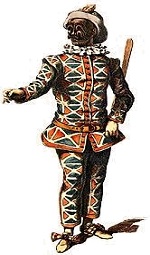
Arlecchino (Harlequin)
This is the mask of "Arlecchino", best known as Harlequin, probably the most famous Commedia character.
Being one of the servants, Arlecchino is like a 5-year-old. He is eager to please his master or mistress (one of the lovers, or Pantalone, or La Signora), lives in the present, loves what he sees, forgets what is out of sight. His first attention is to food: how to get it, how to savor it, how to preserve it for later. He loves tricks and physical antics (known as "Lazzi"). He relishes his adroitness at getting out of difficult situations and seldom considers the consequences until it is too late. Never malicious, Arlecchino is sympathetic to everyone's misfortunes, to a fault.
Arlecchino usually cannot read, which makes him confuse messages sent by lovers. He is ignorant yet clever; slow mentally but quick physically. His actions and moods can change in an instant. He may fall in love with Columbina, but it is puppy love, never lustful.
Physical Characteristics
His lower back is arched, and his arms are often bent with hands on his hips, in readiness to serve. His legs turn out in 4th position, sometimes with heels together and other times with the back knee bent and the front leg straight, like a Baroque bow. He runs quickly and lightly, kicking his feet forward. He sneaks to steal food with large, exaggerated, silent steps. He can stop in an instant, especially when caught in one of his pranks. He carries a slapstick, which makes noise when it hits something and serves as a potential weapon, musical instrument, magic wand, eating utensil, or phallus.
An appropriate animal image for Arlecchino is an Irish setter puppy.
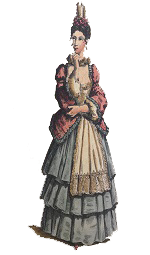
Columbina (Servant)
Columbina, one of the most famous female servants, also known as Servetta. She was a first Zanni and usually did not wear a mask.
She was fresh and frisky, usually servant to the young lover or Isabella and was the smartest character in a scenario. She was autonomous, self-sufficient, and quite rational. Usually paired with Arlecchino, she was sometimes known as "Arlecchine". Other names for the female servant were Franceschina, Smeraldina, Olivetta, Nespola, and Spinetta.
Physical Characteristics
Columbina was not afraid to show her buxom contours or flaunt her robust hips. She was young in spirit but "mothered" the other servants. Originally robust in her gestures, she became lighter in her walk, more engaging in her manner, and less overtly sexual in the seventeenth century. She stands with hands on her hips, or holding a basket or tamborine, while flirting audaciously with the young lover or Capitano, knowing that Arlecchino is her great love.
A comparable animal image for Columbina is a pet cat, smart and cuddly.

Pulcinella (Southern Arlecchino)
Pulcinella developed as a Zanni character from southern Italy; he is the Neapolitan equivalent of Arlecchino from Bergamo in northern Italy. Pulcinello had slow deliberate movement and while he was a 2nd servant was very clever at getting others to do his work for him. He is sometimes portrayed as sensual, sly, keen and intelligent and other times was a course and dull bumpkin, and often cruel. He was not endowed with lively imagination but rather succumbed to vulgarities and lacked delicacy.
His costume was usually white, with a tall white cap. He sometimes is portrayed with a hump and often a large belly, and tended to hop about like a chicken, and was slow and particular in his gestures and speech.
He is a descendent of Maccus and Bucco of Atellana and evolved in England into Punch (the English thought the character was Punchinella), of the popular Punch and Judy shows.

Brighella (Evil Servant)
This is the mask of "Brighella", "first zanni" of Bergamo and one of the most disturbing of the Commedia characters.
Brighella is a crafty, quick, unscrupulous servant who was often paired with Arlecchino. He thrives on double dealings, intrigues, and foul play. Having the highest status of the servants, he is sometimes depicted as an innkeeper, shop owner, valet, or soldier--cunningly separating patrons from their cash and possessions. He is a cynical liar who only looks out for himself and is never repentant when caught in wrongdoing. He is sleazy, seductive, dangerous. He executes his crimes ingeniously. He offers assistance to innocents, scoping opportunities to steal from the unsuspecting. Money for him is worth only the pleasure it provides, and he loves nothing but his own pleasure. He is a drunkard and boisterous sinner who readily insults anyone weaker. With stronger men, he fawns on them or shrewdly slips away.
Physical Characteristics
Brighella is lazy but can move quickly, almost imperceptively. He slinks without muscular effort, and he stays still, ready to pounce. He might blithely be cleaning his nails with the knife which will soon cut a throat. He is very powerful but conserves his energy. He sleeps with one eye open. He gets very close to people when he speaks. He can sing and dance, and drink with the best of them. His costume is usually trimmed in green.
A comparable animal image for Brighella is a rat, snake, or large cat.

Scapino (Scapin)
This was another Servant character, known for his striped costume and musical abilities. The stripes signified his mischievous, sometimes evil intents—a devilish character. He was another character beloved by the French theatre and Moliere in the 17th c.
Old Men
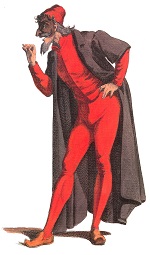
Pantalone (Miser)
This is the mask of "Il Magnifico", best known as Pantalone.
Pantalone was one of the Old Men of the Commedia scenarii. He
originated in Venice as a wealthy, miserly, paranoid, lustful merchant;
a model for Shylock in Shakespeare's "The Merchant of Venice". He
professes poverty but money is his obsession. He finds elaborate ways
to hoard it, count it, hide it, manipulate deals, and avoid spending. He
is lascivious and thinks he is a master at seducing beautiful young
women, but if he had to choose between a beautiful young woman and
money, he would go first for the money. While he seems to control
finances in the Commedia scene, he suspects that everyone is out to
deceive him, and he may be right, since he usually gets duped in the end.
He complains about his physical ailments: aching back, bad knees,
gout, etc. that conveniently come and go at his discretion. He is
sometimes married to the La Signora character, and/or is the father of
one of the young lovers (inamorata), or he is lusting after a sweet
young thing. He wants his son or daughter to marry into a family with
money and is especially disgruntled by his lazy or lustful son.
Physical Characteristics
His pelvis is tilted under but he is not hunched over, as one might
mistakenly do in playing an old man. His knees are bent with his heels
together, toes pointing outward; he runs and walks heels first. His
hands and fingers actively fidget in counting money or holding his
money pouch (which conveniently hangs down between his legs). In
spite of being old and sick, he is surprisingly agile. He can be quite
acrobatic when being foiled by servants, beautiful women, and his
family. Pantalone usually has a curled, pointed beard, red leggings,
and a long cape (denoting higher status).
A comparable animal image for Pantalone is a turkey or rooster.
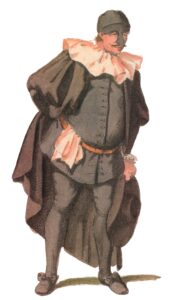
Il Dottore (Doctor of Everything)
This is the mask of Il Dottore, the pedant from Bologna (site of the oldest European university). Il Dottore professes to know everything, but actually knows nothing. He loves to hear himself speak and expounds on answers, whether asked or not (but he is always wrong). He claims to be a doctor of medicine, philosophy, science, law, language, literature, art, politics, or the classics, or all of them. He is a delightfully pretentious bag of wind.
His mask covers the forehead and nose, signifying his heady thoughts and nosy intrusions.
His sense of space is broad, like his girth. He bounces when he walks and uses his hands expressively to clarify his vivid ideas and descriptions. When Il Dottore enters a room, he demands attention and respect through his non-stop orations engaging non-sensical Latin and Greek sounding phrases, signifying nothing.
A comparable animal image is the howler monkey.
Lovers
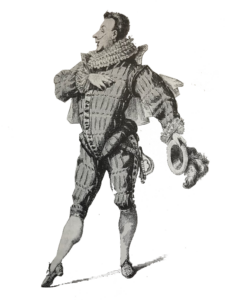
Lelio (Male Lover)
In Italian they called Innamorati and are essential to Commedia plots. There are often two sets of lovers so the four continually get confused with who is in love with whom. Their props are often letters that get mishandled and misread (especially if their zanni have switched the letters).
Characteristics: They “float” with a sense of eternal Love, and are always off balance. Their sense of space is out beyond themselves, as if ultimate love is the universe. They relate primarily to themselves and are actually in love with Love, not necessarily a particular person.
The Lovers do not wear masks, unless they are the Cavalliere, seeking to fight to the death because they think they have lost their love anyway.
When they move, it is usually only two or three steps at a time and diagonally. Their balance hovers on one foot, awaiting word about love, or their lovers.
They have two ultimate emotions, exaltation and desperation, and their lives go back and forth between those two. They can be physically ugly when love is threatened.
They are known by such names as Isabella, Flaminia, Lidia, Silvia, Angelica, Ortensia for the women; and Flavio, Lelio, Fabrizio, Leandro, Aurelio for the men.

Young Isabella (Female Lover)
In Italian they called Innamorati and are essential to Commedia plots. There are often two sets of lovers so the four continually get confused with who is in love with whom. Their props are often letters that get mishandled and misread (especially if their zanni have switched the letters).
Characteristics: They “float” with a sense of eternal Love, and are always off balance. Their sense of space is out beyond themselves, as if ultimate love is the universe. They relate primarily to themselves and are actually in love with Love, not necessarily a particular person.
The Lovers do not wear masks, unless they are the Cavalliere, seeking to fight to the death because they think they have lost their love anyway.
When they move, it is usually only two or three steps at a time and diagonally. Their balance hovers on one foot, awaiting word about love, or their lovers.
They have two ultimate emotions, exaltation and desperation, and their lives go back and forth between those two. They can be physically ugly when love is threatened.
They are known by such names as Isabella, Flaminia, Lidia, Silvia, Angelica, Ortensia for the women; and Flavio, Lelio, Fabrizio, Leandro, Aurelio for the men.
Warriors
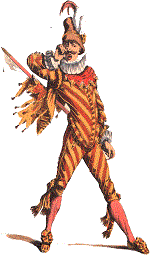
Capitano (Cowardly Braggart)
This is the mask of Il Capitano, the cowardly braggart soldier. He is the foreigner in the scenario, speaking with an accent (or two), who enters to conquer arrogant foes, to rescue young damsels in distress, or to win the hearts of beautiful widows. He is, however, a wimp. He avoids fighting at all costs by deflecting conflicts, feigning death, or outsmarting aggressors. He vainly claims superior physical prowess on the battlefield and in bedchambers all over the world but fails at everything. In his mind, anyone is a fool who cannot recognize his beauty, strength, sensitivity, and foresight. In fact, he is usually penniless and easily intimidated. He is often the suitor of La Signora in a scenario, but seldom wins her over in the end.
Some of the il Capitano masks have long noses, signifying brawn over brains (the longer the nose, the fewer the brains..)
His sense of space is the vast world around him for fighting. He holds his weapon strongly and aggressively (anything from an old, rusty or crooked sword to a stick he thinks is a sword but doesn't really know how to use it. When bragging, he stands tall and has a wide stance, with feet firmly planted. When avoiding conflict, he becomes small and shy, shriveling and shivering in fear. He can run very fast when necessary.
A comparable animal image is the bantam rooster.

Coviello (Southern Character)
This is the mask of Coviello, one of the lesser known Commedia characters, but fun to play.
Coviello was often depicted as a neighbor of Pantalone, lower status, but possible husband to Pantalone's daughter. Some say he was a servant (zanni) from Southern Italy, who--once freed-- acted like a capitano. He was a complainer, but also sly, adroit, and conceited.
Physical Characteristics
Coviello moves more like a capitano (wide, grounded stance, large gestures) than a servant. He can be sly and slinky at times and moves quickly when he needs to. He often uses confused language.
A comparable animal image for Coviello is a hyena.
Special Characters

Smeraldina (Witch Servant)
This female servant was independent, feisty, sensuous, crafty and was often considered a witch. She is comparable to Brighella in her ability to charm while pickpocketing or duping another woman’s lover. She could mesmerize with her singing, or hypnotize with her stories, and always had a hearty laugh.
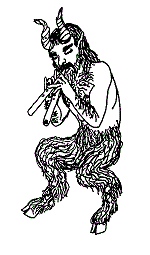
Satiro (Devil in Pastoral)
This is the mask of a Satiro character from a commedia pastorale.
These "creatures" bridged the world of fantasy and reality. They were clever, mischievous, and without morals. They magically disquised themselves or the environment, changing one tree into a forest where the lovers could hide, transforming themselves into messenger bees, cavaliers, pets, or convenient servants. They relished in creating havoc for all the lovers, old men, capitano, and dottore, while assuring a happy ending. These are the characters that inspired Puck and the Fairy kingdom. Like Pan, "satiro" is the guardian of the shepherds and player of music. He is also prone to drinking, partying, and lusting after women.
Physical Characteristics
The physicality is like that of a satyr--the body of a man, the feet of a goat. In donning this mask, one should rise up onto the balls of the feet, never letting the heels down. The body becomes anything it needs to promote the storytelling, from human, to environment, to atmosphere. This character can move very quickly and can be still indefinitely. Shakespeare’s Puck might be derived from Satiro.
A comparable animal image for Satiro is a goat.

Scaramuccio (Scaramouche)
This was a freed servant character from southern Italy concerned with the realms of food, sex, and the body. He was a skilled swordsman and one of the most beloved characters of French theatre in the 17th c.

Pierrot (French Pedrolina)
This French Commedia character evolved from the Italian servant, Pedrolino, and the Sicilian Peppe-Nappa, two characters who did not wear masks but rather powdered their faces. They were servants who tried to make everything perfect and right, but rarely succeeded. They were rather effeminate in their gestures, walked with a shy, soft, rhythmic gait, and spoke with mysterious softness and fluidity. Pierrot became a most popular character in French theatre, opera, and dance, very introverted and often sad. He was known for his oversized white loose clothing and small tear on his cheek.
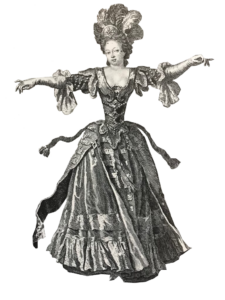
La Signora (Diva-Usually Isabella)
The femme fatale, madonna, diva of Commedia scenarios, La Signora was the wife of Pantalone, or widow adored by all the important men of the town or visiting beauty.
She reveled in bodices and ruffles, beautiful jewelry and petticoats. She was an accomplished dancer, musician, singer, with intelligence and grace. Isabella Andreini made this role important and relevant to women being allowed to act the female roles.

Tartaglia (Old, Blind Sage)
One of the old men of Commedia, Tartaglia was a sage with a stutter, knowing everything, but speaking infrequently because of his speech problems. He was also portrayed as blind, which allowed him to see everything. He moved slowly, cautiously, and purposely, usually uttering some profound understanding through a non sequitur statement.